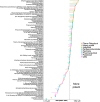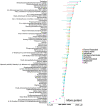This is a preprint.
Analyzing high-throughput assay data to advance the rapid screening of environmental chemicals for human reproductive toxicity
- PMID: 38826231
- PMCID: PMC11142090
- DOI: 10.1101/2024.05.21.595187
Analyzing high-throughput assay data to advance the rapid screening of environmental chemicals for human reproductive toxicity
Update in
-
Analyzing high-throughput assay data to advance the rapid screening of environmental chemicals for human reproductive toxicity.Reprod Toxicol. 2025 Jan;131:108725. doi: 10.1016/j.reprotox.2024.108725. Epub 2024 Oct 16. Reprod Toxicol. 2025. PMID: 39419704
Abstract
While high-throughput (HTP) assays have been proposed as platforms to rapidly assess reproductive toxicity, there is currently a lack of established assays that specifically address germline development/function and fertility. We assessed the applicability domains of yeast (S. cerevisiae) and nematode (C. elegans) HTP assays in toxicity screening of 124 environmental chemicals, determining their agreement in identifying toxicants and their concordance with reproductive toxicity in vivo. We integrated data generated in the two models and compared results using a streamlined, semi-automated benchmark dose (BMD) modeling approach. We then extracted and modeled relevant mammalian in vivo data available for the matching chemicals included in the Toxicological Reference Database (ToxRefDB). We ranked potencies of common compounds using the BMD and evaluated correlation between the datasets using Pearson and Spearman correlation coefficients. We found moderate to good correlation across the three data sets, with r = 0.48 (95% CI: 0.28-1.00, p<0.001) and rs = 0.40 (p=0.002) for the parametric and rank order correlations between the HTP BMDs; r = 0.95 (95% CI: 0.76-1.00, p=0.0005) and rs = 0.89 (p=0.006) between the yeast assay and ToxRefDB BMDs; and r = 0.81 (95% CI: 0.28-1.00, p=0.014) and rs = 0.75 (p=0.033) between the worm assay and ToxRefDB BMDs. Our findings underscore the potential of these HTP assays to identify environmental chemicals that exhibit reproductive toxicity. Integrating these HTP datasets into mammalian in vivo prediction models using machine learning methods could further enhance the predictive value of these assays in future rapid screening efforts.
Keywords: New Approach Methodologies (NAMs); aneuploidy; benchmark dose modeling; benchmark response; chemical assessment; developmental toxicology; germ cell development; meiosis.
Conflict of interest statement
Declaration of Competing Interest The authors declare that they have no known competing financial interests or personal relationships that could have appeared to influence the work reported in this paper.
Figures






Similar articles
-
Analyzing high-throughput assay data to advance the rapid screening of environmental chemicals for human reproductive toxicity.Reprod Toxicol. 2025 Jan;131:108725. doi: 10.1016/j.reprotox.2024.108725. Epub 2024 Oct 16. Reprod Toxicol. 2025. PMID: 39419704
-
Screening and characterization of 133 physiologically-relevant environmental chemicals for reproductive toxicity.Reprod Toxicol. 2024 Jun;126:108602. doi: 10.1016/j.reprotox.2024.108602. Epub 2024 May 8. Reprod Toxicol. 2024. PMID: 38723698 Free PMC article.
-
Environmental impact on vascular development predicted by high-throughput screening.Environ Health Perspect. 2011 Nov;119(11):1596-603. doi: 10.1289/ehp.1103412. Epub 2011 Jul 25. Environ Health Perspect. 2011. PMID: 21788198 Free PMC article.
-
FutureTox IV Workshop Summary: Predictive Toxicology for Healthy Children.Toxicol Sci. 2021 Apr 12;180(2):198-211. doi: 10.1093/toxsci/kfab013. Toxicol Sci. 2021. PMID: 33555348 Free PMC article. Review.
-
ToxRefDB v2.1: update to curated in vivo study data in the Toxicity Reference Database.Front Toxicol. 2023 Sep 11;5:1260305. doi: 10.3389/ftox.2023.1260305. eCollection 2023. Front Toxicol. 2023. PMID: 37753522 Free PMC article. Review.
References
-
- How common is infertility? | NICHD - Eunice Kennedy Shriver National Institute of Child Health and Human Development [Internet]. 2018. [cited 2024 Feb 8]. Available from: https://www.nichd.nih.gov/health/topics/infertility/conditioninfo/common
-
- Vallombrosa Consensus Statement on Environmental Contaminants and Human Fertility Compromise. Semin Reprod Med. 2006;24:178–90. - PubMed
-
- CDC. Data & Statistics on Birth Defects | CDC [Internet]. Centers for Disease Control and Prevention. 2020. [cited 2022 Oct 7]. Available from: https://www.cdc.gov/ncbddd/birthdefects/data.html
-
- National Center for Health Statistics: Infertility [Internet]. 2021. [cited 2022 Oct 7]. Available from: https://www.cdc.gov/nchs/fastats/infertility.htm
Publication types
Grants and funding
LinkOut - more resources
Full Text Sources
